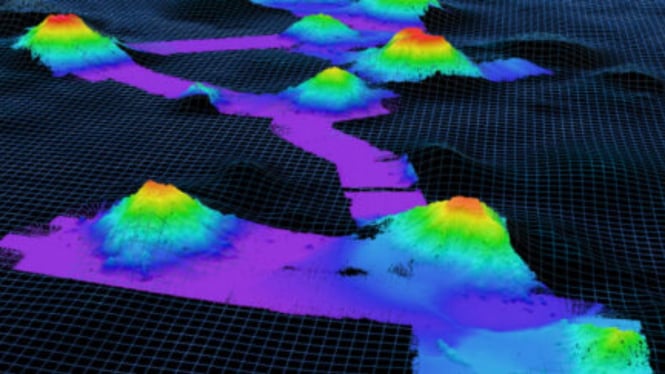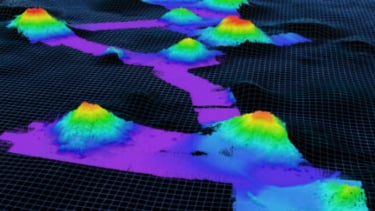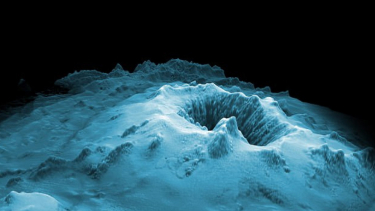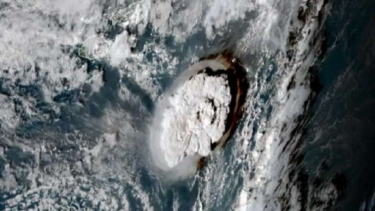- NOAA
VIVA – The team of oceanographers from the Scripps Institution of Oceanography at the University of California San Diego, Chungnam National University in South Korea, and the University of Hawaii discovered over 19,000 new underwater volcanoes by used radar satellite data to map the volcanoes, and published their findings in the Earth and Space Science journal.
There could be over a million underwater volcanoes across the sea floor, but nobody knows just how many as much of the ocean's floor has still not been explored. According to the study, only 20 percent of the seafloor has been mapped by ships.
Julie Gevorgian, a research data analyst at The Scripps Institution of Oceanography and co-author of the study, said: "There have been a handful of studies that predicted there could be thousands of seamounts on the ocean floor. Even then, 19,000 new seamounts is still incredible to think about."
"Especially when you realize just how big these seamounts are and how they were previously unknown. It really is all due to the improvement in the gravity data from satellite altimetry throughout the last few years which has allowed scientists to better understand the topography of the seafloor," he added.
Gunung bawah laut.
- www.dailymail.co.uk/University of Tasmania and Australia Woods Hole Oceanographic Institution
The same as land volcanoes, underwater volcanoes either form by tectonic plates colliding, or a volcanic eruption. Underwater volcanoes are also known as seamounts.
Seamounts are valuable, knowing where they are can assist with sea mining efforts as well as bettering submarine pathways. Two U.S. submarines have run into seamounts before, which can pose danger to the crew, a press release detailing the study said.
Mapping the location of seamounts can also help scientists understand the Earth's tectonic plates and geomagnetic field. The study said the volcanoes can be an insight into the composition and temperature of the Earth's mantle.
Seamounts affect deep ocean currents. When currents collide with seamounts, they get pushed toward the surface, carrying cold water. As the oceans are absorbing more carbon dioxide due to climate change, this can be important to analyze. Seamounts are vibrant with minerals and can provide a habitat for an abudance of marine life.
So, scietists set out to explore and map as many seamounts as possible, in order to understand what lies on the ocean floor a little better.
The 19,325 seamounts discovered were previously unknown to science. The satellites used to discover them could not take pictures of the seamounts, but they were able to discern differences in the altitudes and gravitational pull.
"There can definetly be many more small seamounts globally. Our current altimetry data has a resolution of about 6 km, which means seamounts with a diameter smaller than 6 km will not be located," Gevorgian explained.
"These small seamounts have smaller mass and produce smaller gravity signatures which are difficult to identify in the altimetry data. For example, this might be the case near fast spreading ridges which can have many small volcanoes," he added.
Foto satelit erupsi gunung berapi bawah laut di Tonga yang memicu tsunami.
- NOOA-BBC
Previous studies such as Kim & Wessel, 2011 have mentioned that there could be 50,000 globally and the amount of them increases with a decrease in size.
Our study, Gevorgian said, definitely helped make progress in the global seamount catalog, but improvements in the data resolution can help us find more.
The new seamounts discovered in this study will be added to the 2011 Kim–Wessel catalog, also known as the Global Seamount Database which, before this research, mapped 24,643 seamounts. There are now a total of 43,454 seamounts mapped.
According to the National Oceanic and Atmospheric Administration, three-quarters of all of Earth's volcanic activity happens in deep water. Sometimes, but very rarely, eruptions can be dangerous. Underwater volcanoes can trigger tsunamis, however, to do so, they have to not be too far below the sea surface.
It is usually uncommon for seamounts to have explosive eruptions like some we see on land volcanoes.
This is because, at these depths, the water pressure creates an immense weight. So when an underwater volcano erupts, it will create a passive lava flow along the seafloor. These eruptions usually cannot be seen at the surface of the ocean.





























